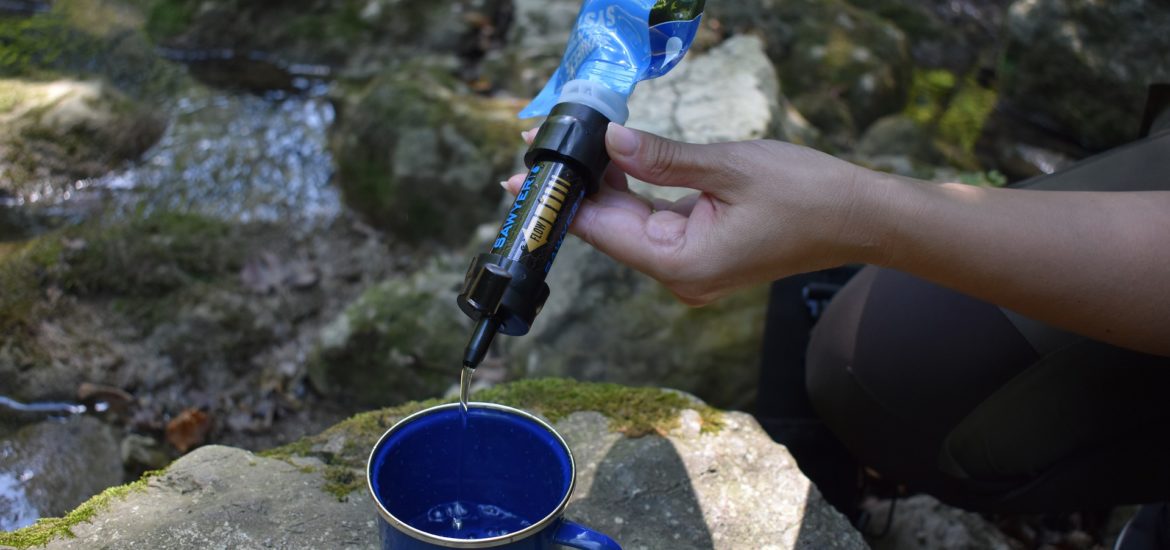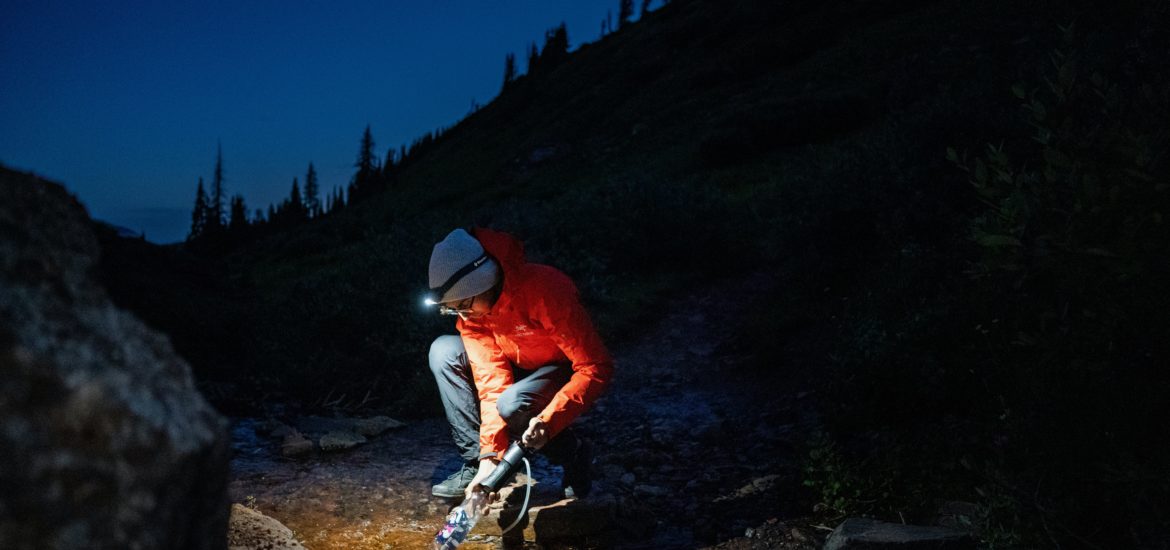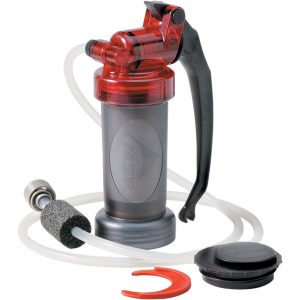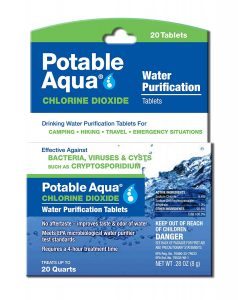It’s critical that access to and consumption of safe drinking water is included when planning any camping trip.
This is especially true when camping in the backcountry. Sources of water such as rivers, lakes, and streams can appear to be free and clear of pathogens.
However, neglecting to apply adequate water treatment methods can expose you to water-borne diseases and infections.
So, it’s important to understand the risks and implement the right techniques to ensure you can safely consume water while camping.
Article Contents:
- Water-borne Diseases
- Exposure to Diseases
- Difference Between “Filtration” & “Purification”
- Gravity vs. Pump Water Filters
- Best Water Filters
- Water Purification Tablets & Drops
- Best Water Purification Tablets for Camping
- Boiling Water
Why is Water Treatment Important When Camping?

Water-borne Diseases
The first step in understanding why it is dangerous to drink water directly from bodies of water such as lakes, rivers and streams is to understand what pathogens might be present.
There are two types of pathogens campers need to be aware of:
- Micro-organisms such bacteria, protozoa and parasites
- Viruses
In North America, the two most common water-borne bacteria campers are likely to come into contact with are E. coli and Giardia (aka “beaver fever”). Both forms of bacteria primarily originate from human and animal wastes. Ingesting contaminated water may lead to cramps, diarrhea and vomiting [Reference].
Likewise, campers need to consider exposure to viruses such as norovirus and hepatitis A. Just like bacteria, these viruses are spread via fecal matter and share similar symptoms such as diarrhea, vomiting, and fever [Reference].
Exposure to Diseases
Treated running water is definitely a luxury when camping. However, for backcountry camping, water must be either packed-in or treated while at site.
The obvious sources of water include lakes, streams, rivers and springs. But, these natural bodies of water are shared with all sorts of creatures. Fish, bird, reptile and human interactions impact the water quality and may result in undrinkable water.
So, unless you are camping next to and drinking water directly from a melting glacier, then you would have to treat water before ingestion. Even if the water looks clear it can still be filled with pathogens.
And, the last thing you want to happen is getting sick while backcountry camping, potentially hours away from medical help.
Water Treatment Methods for Camping

The best way to protect yourself from water-borne pathogens while camping is by being proactive. Treated water will keep you hydrated and prevent sickness.
So, what are the best ways to treat water while camping? Let’s explore the different options below…
Difference Between "Filtration" vs. "Purification"
Well, there is a big difference between water filtration and purification.
Water filters physically remove larger debris and micro-organisms such as micro-plastics, bacteria, protozoa, and parasites, down to 0.5 microns in size [Reference]. Filters do this by passing water through a series of finer and finer media to physically screen-out harmful contents.
On the other hand, water purification chemically treats water for viruses that are too small for filters, typically 0.1 micron and smaller. Chemical agents react with pathogens and render them harmless.
Gravity vs. Pump Water Filters
The two most popular types of water filters used for camping are gravity and pump filters.
Like the name implies, a gravity filter is a passive system. There are no moving parts, only a dirty water reservoir, a filter cartridge, and some tubing to connect everything together.
A great option for most types of camping is a gravity filter system – just fill the reservoir with water, hang it up and let gravity and the filter do the rest. The only thing you need to do is back-flush the filter if the flow drastically decreases.
A pump filter has a mechanical lever which requires you to physically “pump” water through the filtration unit. These types of filters maintain a high flow rate which is mostly dictated by your pumping ability. And when it starts to get too hard to pump, a back-flush is required.
Pump-action filters are a great if you need on-the-go water, for example, while hiking, or canoeing when you can’t spend time waiting for a gravity filter to do its magic.
Best Water Filters

MSR Auto-Flow Gravity Water Filter
Personally, I prefer gravity filters since they are easy to setup and are low maintenance.
The MSR gravity water filter is the best “set it and forget it” water filter on the market. The super simple, two bladder design makes gaining access to clean water ridiculously simple.
Great for backcountry trips, I carry this water filtration system on all my camping trips so I never have to worry about not having clean water.

MSR Pump Water Filter
A pump-action water filter is great if you can’t wait for a gravity filter to do its job.
MSR pump filter actually screws onto your water bottle and filters water directly into it for fast, clean water on the go!

LifeStraw Filter
LifeStraw is a great water filtration system that’s ultra-compact and portable. It’s tailor-made for backpackers, hikers and survivalists.
The LifeStraw is able to filter out debris, plastics and micro-organisms down to 0.2 microns [Reference].
Each LifeStraw can filter up to 4,000 litres of water, which is equivalent to 5-years worth of drinking water for an individual!
Water Purification Tablets & Drops
Chemically treating water purifies and kills various biological organisms and pathogens. Contaminants such as bacteria, viruses, parasites and other water borne diseases will be removed.
By far, the best and most powerful chemical treatment option suitable for camping is chlorine dioxide tablets.
These tablets are effective against bacteria, viruses, Giardia and even cryptosporidium. The tablets do not affect the taste of the water. The treatment time is 45 minutes, however, it takes 4 hours to fully purify the water against cryptosporidium.
Iodine and chlorine (bleach) tablets and solutions are also suitable options which are fast acting (30-45 minutes to be effective). The options, however, do not treat cryptosporidium.
Before heading out, check to see if the area you will be camping in requires any water purification considerations.
Best Water Purification Tablets

Portable Aqua Chlorine Dioxide Tablets
The fully purify water, these chlorine dioxide tablets quickly treat large volumes of water for bacteria, viruses and cysts.
If you’re in a region of the world that may contain contaminated water sources, these tablets offer plenty of peace of mind.
Boiling Water
Boiling water is a proven and reliable way to kill all pathogens, including bacteria, viruses and parasites [Reference].
It is recommended to bring water to a rolling boil for at least 1 minute, then cooled before consumption.
The heat from boiling inactivates or physically damages the structural components of organisms harmful to humans. At higher altitudes, water must be boiled for up to 3 minutes to ensure enough heat is generated.
However, boiling water may not be suitable for high levels of water contamination. Particulate matter in high turbidity and raw sewage water sources impair the effectiveness of boiling [Reference].
The primary drawback of boiling water is amount of fuel needed to burn to produce heat. So, it might not be feasible to boil water while camping. Filtration or purification might be an easier and overall cheaper method for treating water.
If you need help finding the best stove for boiling water, check out my article How to Pick the Best Camping Equipment How to Pick the Best Camping Equipment: Tents, Tarps, Stoves, and More!
This article contains affiliate links, which help support this blog at no cost to you!

Pingback: What is Bivouacking? - Ultralight Backpacking Shelter Explained
Pingback: What is Bivouacking? - Ultralight Shelters Explained [Bivy Sack]